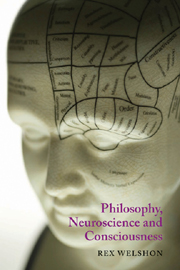Book contents
- Frontmatter
- Contents
- Preface
- Introduction
- PART I PHILOSOPHY AND CONSCIOUSNESS
- PART II NEUROSCIENCE AND CONSCIOUSNESS
- PART III PHILOSOPHY, NEUROSCIENCE AND CONSCIOUSNESS
- 9 Measurement, localization, models and dissociation
- 10 Correlates, realizers and multiple realization
- 11 Microphysical reduction, overdetermination and coupling
- 12 Embodied and embedded consciousness
- Concluding semi-scientific postscript
- Appendix Functional neuroanatomy
- Notes
- Bibliography
- Index
10 - Correlates, realizers and multiple realization
from PART III - PHILOSOPHY, NEUROSCIENCE AND CONSCIOUSNESS
- Frontmatter
- Contents
- Preface
- Introduction
- PART I PHILOSOPHY AND CONSCIOUSNESS
- PART II NEUROSCIENCE AND CONSCIOUSNESS
- PART III PHILOSOPHY, NEUROSCIENCE AND CONSCIOUSNESS
- 9 Measurement, localization, models and dissociation
- 10 Correlates, realizers and multiple realization
- 11 Microphysical reduction, overdetermination and coupling
- 12 Embodied and embedded consciousness
- Concluding semi-scientific postscript
- Appendix Functional neuroanatomy
- Notes
- Bibliography
- Index
Summary
If microphysical neural reductionism gets things right, conscious properties inherit all their causal powers from the microphysical properties of certain neural assemblies and so are totally realized by those microphysical neural properties. A strategy for showing that conscious properties inherit all their causal powers from microphysical neural properties is the following. First, include subjective perspectivity, qualitative character and intentionality in the set of representational properties. Second, include representational properties in the set of functional properties. Third, survey enough of the neuropsychological, neuroimaging and evolutionary evidence to convince doubters that the neural correlates of such functionalized conscious properties are also neural substrates for them. Fourth, invoke a thesis such as (NR)1 to warrant reducing those functionalized properties to certain microphysical properties of neural substrates. Successfully completing these steps provides a blueprint for the kind of arguments for any candidate conscious property to reduce to the microphysical properties of neural assemblies.
The central role of claims such as (NR) in this project is apparent. If (NR) is false, neural reduction collapses. There are three ways to argue that (NR) is false: first, use multiple realization of conscious properties against it; second, deny that conscious properties are totally realized by microphysical properties; third, deny that conscious properties are totally realized by neural properties, microphysical or not. In this chapter, multiple realization is rejected. In the final two chapters, we consider the second and third, considerably more challenging, objections.
- Type
- Chapter
- Information
- Philosophy, Neuroscience and Consciousness , pp. 220 - 242Publisher: Acumen PublishingPrint publication year: 2010

